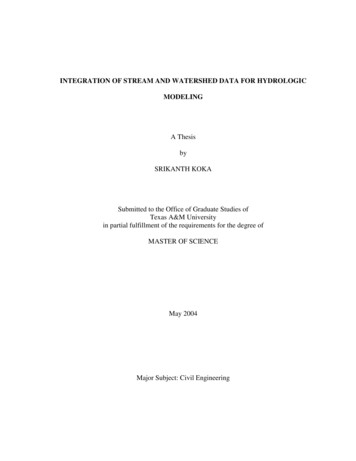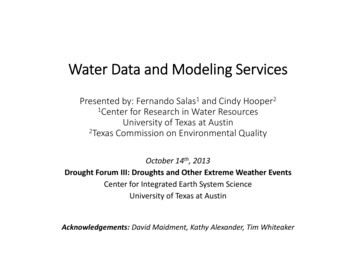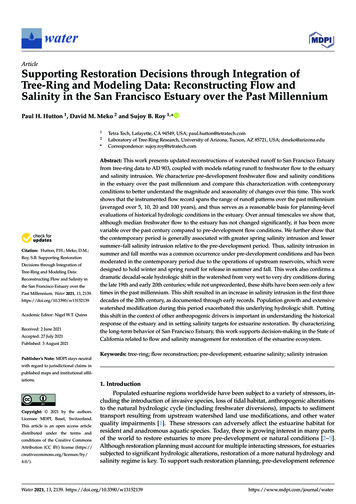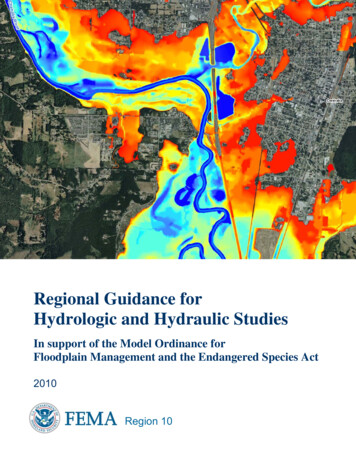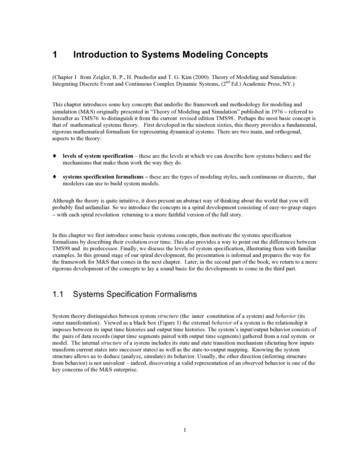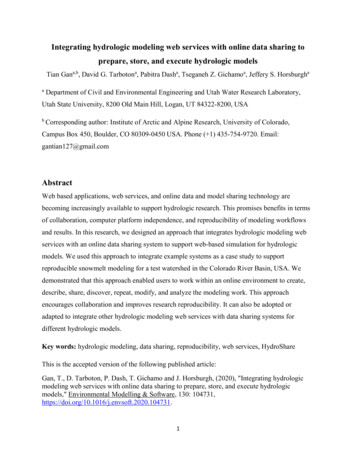
Transcription
Integrating hydrologic modeling web services with online data sharing toprepare, store, and execute hydrologic modelsTian Gana,b, David G. Tarbotona, Pabitra Dasha, Tseganeh Z. Gichamoa, Jeffery S. HorsburghaaDepartment of Civil and Environmental Engineering and Utah Water Research Laboratory,Utah State University, 8200 Old Main Hill, Logan, UT 84322-8200, USAbCorresponding author: Institute of Arctic and Alpine Research, University of Colorado,Campus Box 450, Boulder, CO 80309-0450 USA. Phone ( 1) 435-754-9720. Email:gantian127@gmail.comAbstractWeb based applications, web services, and online data and model sharing technology arebecoming increasingly available to support hydrologic research. This promises benefits in termsof collaboration, computer platform independence, and reproducibility of modeling workflowsand results. In this research, we designed an approach that integrates hydrologic modeling webservices with an online data sharing system to support web-based simulation for hydrologicmodels. We used this approach to integrate example systems as a case study to supportreproducible snowmelt modeling for a test watershed in the Colorado River Basin, USA. Wedemonstrated that this approach enabled users to work within an online environment to create,describe, share, discover, repeat, modify, and analyze the modeling work. This approachencourages collaboration and improves research reproducibility. It can also be adopted oradapted to integrate other hydrologic modeling web services with data sharing systems fordifferent hydrologic models.Key words: hydrologic modeling, data sharing, reproducibility, web services, HydroShareThis is the accepted version of the following published article:Gan, T., D. Tarboton, P. Dash, T. Gichamo and J. Horsburgh, (2020), "Integrating hydrologicmodeling web services with online data sharing to prepare, store, and execute hydrologicmodels," Environmental Modelling & Software, 130: 31.1
Software availabilityThe software created in this research is free and open source as part of the larger HydroSharesoftware repository. The HydroShare software repository is managed through GitHub and isavailable at https://github.com/hydroshare/hydroshare. The HydroShare REST API PythonClient repository is available at https://github.com/hydroshare/hs restclient.The Utah EnergyBalance (UEB) web app software is available in GitHub athttps://github.com/gantian127/tethysapp-ueb app. A snapshot of the code for the app at the timeof this writing was also published in Zenodo (Gan et al., 2020). Code for the HydroDS modelingweb services is available at Hydrologic modeling is essential as a guide to formulating strategies for water resourcesmanagement or as a tool of scientific inquiry (Dingman, 2008). However, hydrologic modelingresearch presents a number of challenges. Modelers need to discover and collect data fromvarious sources (Archfield et al., 2015) and use it to prepare model inputs. Model inputpreparation can be time consuming and may require a substantial learning curve, especiallywhere programming is needed (Miles, 2014). Furthermore, modelers may need to access highperformance computing (HPC) resources to effectively handle large scale or complicatedhydrologic model simulations (Kumar et al., 2008; Laloy and Vrugt, 2012). Curating and sharingmodeling datasets and metadata publicly is also important to improving reproducibility (Demirand Krajewski, 2013; Archfield et al., 2015; Hutton et al., 2016; Essawy et al., 2018; Chuah etal., 2020). Collaboration among people from various disciplines and areas is one of the keyfactors in catalyzing new research findings (Silliman et al., 2008). Computer systems asinfrastructure (cyberinfrastructure) that enable collaboration have the potential to significantlyadvance environmental modeling research.With the development of web technologies and standards, one promising direction is to provideweb services or web applications to help people overcome these hydrologic modeling challengesand improve the efficiency of hydrologic modeling work. There are a number of systems thathelp acquire or preprocess datasets as model input files for hydrologic models (Leonard andDuffy, 2013; Billah et al., 2016; Gichamo et al., 2020). For instance, Billah et al. (2016)2
developed web services that help to automate the grid data pre-processing workflow forpreparation of model inputs for the Variable Infiltration Capacity (VIC) model (Liang et al.,1996). The workflow includes the information that allows others to independently reproduce themodel results and acts as a means for documenting the steps used to create model input files.Some systems focus on simulation using a specific hydrologic model while others coupledifferent hydrologic models to simulate integrated hydrologic processes. For example,SWATShare (Rajib et al., 2016) established a collaborative environment to publish, share,discover, and download Soil and Water Assessment Tool (SWAT) models. Thiscyberinfrastructure also supports SWAT model calibration running on HPC resources andvisualization of model outputs. Souffront Alcantara et al. (2019) developed a large-scalestreamflow prediction system and made the results available using a hydrologic modeling as aservice approach (HMaaS). This approach improves accessibility to modeling results to supportdecision making for developing countries that may have limited hydrologic modelingcapabilities. The Community Surface Dynamics Modeling System (CSDMS) (Peckham et al.,2013) created an environment that promotes the sharing, reuse, and integration of open-sourcemodeling software. Many models in CSDMS are installed and maintained on its highperformance cluster. CSDMS members can access these resources and integrate them forcomplex model simulation. In addition, some systems support both model input preparation andsimulation to facilitate modeling work. The AWARE framework, which is described as “A toolfor monitoring and forecasting Available WAter REsource in mountain environments,” wasdeveloped to offer online geospatial processing services and other tools to help users monitor andforecast water resources in Alpine regions (Granell et al., 2010). Sun (2013) migrated anenvironmental decision support system from the traditional server-client model to Google cloudcomputing services with Google Drive holding some of the data to enable collaborativeparticipatory modeling. Later, recognizing the computational demands of physically basedhydrologic models in a web-based environment, Sun et al. (2015) explored the use of metamodels to support water quality management and decision making. A similar approach was alsoapplied to metamodeling of geological carbon sequestration (Sun et al., 2018). These priorapproaches highlight the importance of easy to use server or web-based methods forcollaborative and reproducible hydrologic modeling similar to those that are addressed in thispaper.3
Although these web services or web applications improve the efficiency of hydrologic modelingwork, they do have limitations. One limitation is that they may require programming to use theweb services and thus be difficult to use for those without the required programming skills orknowledge. Another limitation is related to the reproducibility of the modeling work, an essentialprinciple in scientific research (Hutton et al., 2016). The model input/output files and theprogramming code for data processing and analysis are often not well curated and shared withthe public (Stagge et al., 2019). This hinders the ability for the modeling community toreproduce and verify the modeling work and reuse the results.In this research, our goal was to integrate hydrologic modeling web services with a data sharingsystem to provide web-based simulation that improves the reproducibility of the modeling workand the usability of these web services. We define web-based simulation as the use of webtechnologies to develop, execute, and analyze simulation models with the web browser playingan active role in the modeling process, either as a graphical user interface or as a container forthe simulation engine (Byrne et al., 2010; Walker and Chapra, 2014). We sought to provide anonline environment within which users can prepare model input, execute the model, share andanalyze the results, and repeat or modify the modeling work for collaboration.To achieve this goal, we designed an approach for system integration. The general idea was toadd a browser-based graphical user interface (GUI) for the modeling web services to make themeasy to use without programing knowledge and to take advantage of a data sharing system thatprovides advanced data curation and management capability beyond existing modeling webservices. As a case study, we used this approach to integrate two example systems, HydroDS andHydroShare, to support web-based simulation for a snowmelt model. The functionalityimplemented was evaluated using snowmelt modeling use cases in the Animas watershed withinthe Colorado River Basin, USA. HydroDS (Gichamo et al., 2020) is a set of web-based,hydrological data services that provides access to input datasets and server side data processingtools for distributed hydrologic models such as the Utah Energy Balance (UEB) snow model(Tarboton and Luce, 1996). HydroDS includes a Python client library that makes it easy to usethe hydrological data services in a Python programing environment to automate data processingworkflows. Model input and output files can be temporarily saved in the HydroDS system andare then downloadable for further analysis. HydroShare is a hydrologic information system and4
repository for sharing hydrologic data, models, and analysis tools (Tarboton et al., 2014). InHydroShare, the hydrologic datasets or models can be shared as resources that can be published,collaborated around, annotated, discovered, and accessed (Horsburgh et al., 2015). Aside fromthe data sharing functions, HydroShare also provides a representational state transfer (REST)application programming interface (API) and corresponding Python client library that enablesother systems including web applications (or apps), to interact with HydroShare.The primary contribution of this work is that it demonstrates how the bar for collaborative andreproducible hydrologic modeling can be lowered through facilitating and better enabling the useof web-based hydrologic modeling. This is achieved through GUI and Python Notebook basedweb apps that serve as interfaces to web services and are underpinned by a data repository thatenables users to collaborate and share their results in a reproducible way. We demonstrate howthe capability of data and modeling services can be extended by providing a web browser basedGUI that reduces the programming required for input data preparation and model simulation.This can make the modeling web services available to a broader user community for those whohave limited programming skills. We also demonstrate how integration of modeling web serviceswith a data sharing system can improve the accessibility of modeling work by enabling theresearch community to more easily discover and access modeling workflows for reuse andcollaboration. With these new capabilities, this approach can facilitate research validation andexperimentation in an online environment without using modelers’ local computing or datastorage resources. Additionally, this approach can be adopted or adapted to integrate otherhydrologic modeling web services with data sharing systems for various hydrologic models tosupport reproducible modeling research.In Section 2, we introduce the general architecture design and the case study that uses thisapproach to integrate the two example systems (HydroDS and HydroShare). In Section 3, wepresent the case study results, which describes the integration of the functionality implementedand tested for snow modeling use cases. Section 4 presents discussion and Section 5 summaryand conclusions.5
22.1MethodsGeneral approachThe purpose of the system integration presented here is to support web-based simulation that: 1)provides easy access through a web browser to the modeling web services, 2) provides onlinedata curation and sharing to support management and reuse of the modeling work, and 3) avoidsthe complexity of changing existing systems to achieve system integration.Based on these criteria, we designed a three-layer web service based architecture to integratehydrologic modeling web services with a data sharing system. This architecture includes a userinterface layer, a data service layer, and a data storage layer (Figure 1). The user interface layercan be a web app that provides a web browser based user interface for modelers to use thehydrologic modeling web services without programming. This user interface layer web app canbe hosted on web servers separate from the data service or the data storage layers and interactwith them through REST APIs. This design decouples the user interface web app from the othertwo layers and avoids significant changes in the existing systems. The data service layer is asystem that hosts hydrologic data and modeling web services. This layer can receive webrequests from the user interface layer to prepare model input datasets or execute hydrologicmodels. The hydrologic data is the general use large data, and, in our implementation, contiguousUS wide data used for model input preparation (e.g., climate, land cover, and terrain input data).The data is staged in this layer to enable high availability and performant data access inresponding to web service requests. The data storage layer is a data sharing system for storingand sharing the data specific to users’ modeling work. This design uses the emergingfunctionality of data sharing systems to avoid additional software development work and providethe storage and data curation needs for systems that host hydrologic modeling web services.6
Figure 1 A three-layer web service based architecture to integrate hydrologic data and modelingweb services (e.g., HydroDS) with a data sharing system (e.g., HydroShare).2.2Case study designOur case study was designed to use this general approach and integrate example systems to test ifthe system integration can support web-based simulation to improve research reproducibility andreduce the need for coding to use the modeling web services. We used the three-layerarchitecture to integrate HydroShare and HydroDS, and designed use cases to evaluate theapplication of implemented functionality for snowmelt modeling in a test watershed. We chosethese systems because: 1) they represent the general functionality of hydrologic data andmodeling web services (HydroDS) and data sharing systems (HydroShare); and 2) the authorshave access to both systems and are thus able to work on them for integration. In the following,we first provide background on these systems and then present the case study design.HydroDS is a system that provides web based data services to simplify model input preparationfor distributed hydrologic models (Gichamo et al., 2020). Modelers can use these web services tocreate model input files and save the time and energy often spent collecting datasets frommultiple sources and developing code to preprocess the data into required file formats. Forexample, Table 1 shows the UEB model input variables and the major HydroDS Python clientfunctions used to call the respective web services to prepare them. The UEB model requires7
climate, terrain, and canopy datasets as model input and uses Network Common Data Form(NetCDF; http://www.unidata.ucar.edu/software/netcdf/) as its input/output file format. Modelerscan use HydroDS functions to write data processing code for input preparation. HydroDSdatasets are processed and stored in GeoTiff, shapefile, and NetCDF formats based on thefunctions that generate the datasets. Additionally, HydroDS data conversion functions helpprocess UEB inputs in NetCDF format.Table 1 UEB model input variables and HydroDS Python client functions for input preparation.Input typeSpecific variablesMajor Python client functions forpreparationModel domainWatershed gridsubset raster()delineate watershed()raster to netcdf()TerrainSlopecreate raster aspect()Aspectcreate raster slope()raster to netcdf()CanopyCanopy coverproject clip raster()Canopy heightget canopy variable()Leaf area indexClimateIncoming shortwave radiationsubset netcdf()Minimum air temperatureconcatenate netcdf()Maximum air temperaturesubset netcdf by time()Air vapor pressureproject subset resample netcdf()PrecipitationThe HydroDS system was built using Django, an open-source Python web framework for webdevelopment (https://www.djangoproject.com/) (Figure 2). Several open-source libraries andsoftware programs for processing NetCDF, shapefile, and raster datasets were installed inHydroDS, such as NetCDF4 Python module, NCO (Zender, 2008), GDAL(http://www.gdal.org/), and TauDEM (Tarboton, 1997). They were used to provide the requireddata management and processing capabilities. Additionally, datasets from multiple sources for8
input preparation were also stored in this system, including the National Elevation Dataset(NED) (https://www.usgs.gov/), National Land Cover Datasets (Homer et al., 2015), and Daymetclimate data (Thornton et al., 2016).Figure 2 The HydroDS system architecture.HydroShare’s system architecture (Figure 3) is centered on several open source components(Heard et al., 2014). The major components include Django and iRODS (http://iRODS.org/).Django provides the functionality that was used to build the web user interface to help usersmanage their shared datasets or models. iRODS is open source data management software that isused for data storage and access control. Aside from data sharing functionality, web apps hostedon other web servers can also connect to HydroShare. For example, the Consortium ofUniversities for the Advancement of Hydrologic Science, Inc. (CUAHSI) JupyterHub web app(http://jupyter.cuahsi.org) was developed by others (Castronova, 2016) and connected toHydroShare. This web app was built with the JupyterHub software stack (https://jupyter.org/hub)and configured with many scientific Python libraries and tools. It provides an online9
programming environment where researchers can load data from HydroShare and developPython code for data analysis and visualization. Another example platform for web apps is theHydroShare Tethys Apps portal (https://apps.hydroshare.org/apps/), a system established by theHydroShare team to host multiple web apps and interact with HydroShare resources (Fig. 3).This web portal was built using the Tethys platform (Swain et al., 2016) that includes softwareand development kits to simplify and reduce the programming skills needed to develop web appsfor environmental data visualization, analysis, and modeling applications. In order to enableinformation exchange between HydroShare and the HydroShare Tethys Apps portal, Oauth(https://oauth.net/) is used to support user authentication and authorization, and the HydroShareREST API Python client “hs restclient” (https://github.com/hydroshare/hs restclient) is used totransfer the datasets between the two systems.Figure 3 System architecture of HydroShare and HydroShare Tethys Apps portalIn our case study design, we applied the three-layer architecture based on the features ofHydroDS and HydroShare to support UEB modeling work (Figure 1). A Tethys web app (theUEB web app) was developed and hosted in the HydroShare Tethys Apps portal and serves asthe user interface layer to provide easy access to the HydroDS web services. HydroDS is the dataservice layer used to prepare the model input files and execute the model. HydroShare acts as thedata storage layer to store and share the results created from HydroDS. The main activitybetween the UEB web app and HydroDS is the transfer of user input information to HydroDS formodel input preparation or model simulation. Between HydroDS and HydroShare, the activity ismainly the transfer of model input/output files and associated metadata for modeling work. TheUEB web app also interacts with HydroShare to retrieve the metadata of shared model input filesto facilitate model simulation. We also chose Python for our case study implementation because:1) there is significant momentum and a growing community of Python development within thescientific computing community; 2) both HydroDS and HydroShare have available Python client10
libraries that facilitated more rapid development; and 3) the availability of open-source Pythonlibraries and development tools facilitated our work.We evaluated the system integration for two snowmelt modeling use cases. These use cases weredesigned to use the web-based simulation functionality to test the sensitivity of the UEB modeloutputs to different grid cell resolutions of the model input files. The results can help modelersevaluate the tradeoffs between model performance and computational as well as data storagerequirements. In the first use case, a user prepares model input, executes the model, and curatesthe results in HydroShare. In the second use case, another user discovers the shared modelingwork in HydroShare and modifies the work to derive new results with different grid cellresolution and compares the snowmelt model outputs from the two use cases.3Results3.13.1.1System integrationUser interface layerThe UEB web app was developed as a Tethys web app and hosted in the HydroShare TethysApps portal to provide a graphical user interface for the HydroDS web services. The HydroShareTethys Apps portal hosts various web applications to support data visualization, analysis, andmodel simulation. This platform was designed to lower the barrier for the development ofenvironmental web apps and is targeted at scientists and engineers who have some scientificprogramming experience, but not necessarily web development experience (Swain et al., 2016).Swain et al. showed that, compared to creating a website project from scratch, using the Tethysplatform can reduce the need to learn multiple languages for web app development and the totalnumber of lines of code for each web app.We chose HydroShare Tethys Apps portal to host the UEB web app for several reasons. First,and in general, using a web app portal decouples the user interface application from the systemsthat host data and hydrologic modeling web services. Loosely coupled systems allow changes inone system component without big changes in the other system components making them easierto maintain. Second, Tethys platform provides software development kits to simplify and reducethe coding and learning of web programming languages required for web app development.11
The UEB web app was designed to provide three functions: model input preparation, modelexecution, and job status checking. Users can interact with this web app to perform modelingwork without writing program code to simplify access to HydroDS. Figure 4 (a) shows the userinterface for model input preparation. This has two main sections: the user input form section onthe left and the map view section in the center. The user input form section allows the user toenter settings to create a complete model input package for model simulation. The map viewsection helps the user draw a bounding box and optionally an outlet point to specify the modelingdomain. If just a bounding box is provided, the entire bounding box is used as the model domain.If an outlet point is provided, the watershed draining to the outlet is computed within thebounding box and used as the domain. The user needs to ensure that the bounding box issufficient to contain the entire watershed draining to the outlet point.After the user fills out the form and clicks on the “Input Data Preparation” button, the webrequest is sent to HydroDS and a corresponding job ID is returned so that the UEB web app canmonitor the status of the submitted job. Figure 4 (b) shows the user interface for modelexecution. It also has two main sections: the model input information section on the left and themap view section. The model input information section allows the user to select a model inputpackage stored in HydroShare. When the user selects a model input package, its correspondingmetadata is retrieved from HydroShare and shown in this section. Furthermore, if the metadataincludes the bounding box and outlet point information for the modeled domain, it will beautomatically shown on the map to orient the user geographically. After the user clicks on the“Submit Model Execution” button, the web request is sent to HydroDS, and the correspondingjob ID is returned so that the UEB web app can monitor the job status. Figure 5 shows the jobstatus checking user interface where the status of submitted model input preparation or modelsimulation jobs is shown. When the job is completed successfully, the user is provided with alink to the resource in HydroShare that stores the model input package (in the green frame) ormodel output files (in the red frame). If the job fails, the user will be provided with detailed errorinformation (in the yellow frame).12
(a)(b)Figure 4 User interface of the UEB web app for input preparation (a) and model execution (b).13
Figure 5 User interface of the UEB web app for job status checking.The UEB web app was built based on Tethys, which by default includes a narrow left panel anda wide right panel in the main app section. We designed the app to display a map in the main appsection and parameter entry form with control buttons on the left. Menu bars at the top were usedto switch between steps in the designed use of the app, which can provide the user with guidanceon the functionality of each page. Implementing this design required customizing the defaultHypertext Markup Language (HTML) and cascading style sheets (CSS) script provided byTethys. The user input forms in the left panel were implemented using Bootstrap, an open-sourcefront-end web framework (http://getbootstrap.com/) and the Template Gizmos s sdk/gizmos.html) from the Tethys softwaredevelopment kit. The map view in the right panel was implemented using the Google MapsJavaScript API (https://developers.google.com/maps/). Additionally, the HydroShare REST APIPython client was used to manage all the interactions between the user interface layer and thedata storage layer. For example, the metadata for existing model input packages fromHydroShare can be retrieved using the Python client and displayed on the model executioninterface. We also created a resource for the UEB web app in HydroShare (Gan et al., 2020).This resource stores the metadata information of the UEB web app and helps users to discoverand launch the web app through HydroShare for hydrologic modeling research.14
3.1.2Data service layerTo support the work described in this paper, we implemented new web services and jobsubmission capability in the HydroDS system, which were used by the UEB web app for modelinput preparation, model simulation, and job status checking. This was an extension of theoriginal design for the HydroDS web services (Gichamo et al., 2020), which required users tomake multiple web requests to process various datasets for input preparation (Table 1). It isinefficient for the UEB web app to send multiple web requests to HydroDS and periodicallycheck for completion. Thus, we used the existing data processing functionality in HydroDS andimplemented a new web service for model input preparation, which enables the user to click onthe “Input Data Preparation” button in the UEB web app to submit a single web request toHydroDS to accomplish the work. Figure 6 (a) shows the detailed tasks done by this new webservice. It first creates a complete UEB model input package that includes both the input datafiles and the model parameter files. Then, it generates a Python file to document the details ofhow the model input package can be created using the HydroDS Python client. Finally, ittransfers all of the files and associated metadata to HydroShare. In this web service, the Pythonscript created was designed to provide input preparation details instead of hiding the processingwork behind the scenes as a black box to users. This design ensures that novices can view andlearn from the syntax of the Python script, using it as an example to learn how to use HydroDSweb services and create input preparation workflows for other hydrologic models. It also focuseson another major target user group for this system – i.e., modelers who want better tools to maketheir work easier but who still want to know the coding details of the research. For both types ofusers, this Python script can be reused to reproduce or derive new model input for the UEBmodel.We also implemented a new web service that is called when the user clicks on the “SubmitModel Execution” button in the UEB web app to make a single web request to HydroDS formodel simulation. Figure 6 (b) presents the specific tasks accomplished by this web service. Itfirst downloads the model input package from HydroShare into HydroDS. Then, it validates themodel input package to check if there are missing files required for executing the model. If thevalidation is successful, HydroDS executes the UEB model and then transfers the model outputfiles and stores them with the model input package in HydroShare. To support data transfer15
between the data service and data storage layers, the HydroShare REST API Python client“hs restclient” was used for reading and writing files and metadata to and from HydroShare.In order to improve the user experience by supporting job status checking and display in theUEB web app, we also added job submission ca
hydrologic modeling web services with a data sharing system. This architecture includes a user interface layer, a data service layer, and a data storage layer (Figure 1). The user interface layer can be a web app that provides a web browser based user interface for modelers to use the hydrologic modeling web services without programming.

